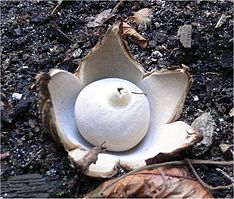Geastrum fimbriatum
| Geastrum fimbriatum | |
|---|---|
 |
|
| Scientific classification | |
| Kingdom: | Fungi |
| Division: | Basidiomycota |
| Class: | Agaricomycetes |
| Order: | Geastrales |
| Family: | Geastraceae |
| Genus: | Geastrum |
| Species: | G. fimbriatum |
| Binomial name | |
|
Geastrum fimbriatum Fr. (1829) |
|
| Synonyms | |
| Geastrum fimbriatum | |
|---|---|
| Mycological characteristics | |
| glebal hymenium | |
| no distinct cap | |
| spore print is brown | |
| ecology is saprotrophic | |
| edibility: inedible | |
Geastrum fimbriatum, commonly known as the fringed earthstar or the sessile earthstar, is an inedible species of mushroom belonging to the genus Geastrum, or earthstar fungi. First described in 1829, the species has a widespread distribution, and is found in Asia, Europe, and the Americas. It is distinguished from other earthstars by the delicate fibers that line the circular pore at the top of its spore sac.
Elias Magnus Fries described Geastrum fimbriatum (as Geaster fimbriatus) in his 1829 Systema mycologicum.
It is commonly known as the fringed earthstar or the sessile earthstar. The specific epithet fimbriatum means "fringed", referring to the characteristic edge of the apical spore of the spore sac.
The fruit bodies of Geastrum fimbriatum start out roughly spherical and hypogeous. As it matures, it pushed up through the soil and the other layer of the spore case (exoperidium) splits open to form between 5 and 8 rays that curve downward. The fully expanded fruit body has a diameter of up to 3 cm (1.2 in). Before expansion, the outer surface has a cottony surface with adherent soil particles; this ultimately peels off to reveal a smooth, grayish-brown surface. The inner spore sac is yellowish brown and features a small conical pore with fringed edges. Unlike other similar earthstar fungi, the edges of this pore are not sharply delimited from the rest of the spore sac, and do not have grooves. The fruit bodies have no distinctive taste or odor.
The spores are spherical, roughened by many small points or warts, and measure 2.4–4 μm. The capillitium is thick-walled, unbranched, and 4–7 μm thick.
Similar species include Geastrum saccatum, which is larger – up to 5 cm (2.0 in) across – and has a clearly delimited ring-like area around the pore opening. Geastrum rufescens has reddish tones that are absent from G. fimbriatum.
Although typically listed by field guides as an inedible species, it is eaten by the tribal peoples of Madhya Pradesh.
...
Wikipedia
